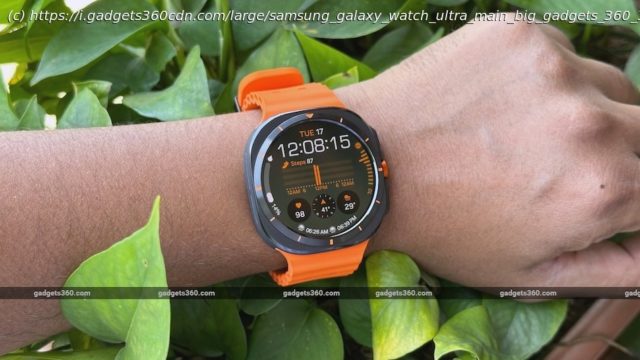The Samsung Galaxy Watch Ultra sure looks the part for a multisport or triathlete watch, but comes up a bit short in terms of delivery, which is mainly down to its hardware support. It has a ruggedised design which is partially made of out titanium but cannot withstand diving depths and so cannot be used as a dive computer. Performance is great but battery life is average for a WearOS device and far behind some competing smartwatches both below and above this price point.
Samsung’s Galaxy Watch Ultra is the newest member of its Galaxy Watch lineup. It’s technically the successor to the Samsung Galaxy Watch 5 Pro, which was launched in 2022. But just like last year, Samsung has spring-cleaned its smartwatch lineup this year by eliminating the Classic model of the standard Watch 7 entirely. And once again, we are left with just two models, which include the new Galaxy Watch Ultra and the Galaxy Watch 7, with the more affordable Galaxy Watch FE still awaiting an India launch.
Oddly, if you compare the new smartwatches on Samsung’s website, there are minor differences between the two models on paper, save for the obvious rugged-ised design of the Ultra. So, is the new Galaxy Watch Ultra (priced at Rs. 59,999) worth the Rs. 23,000 premium over the 44mm version of the Galaxy Watch 7? Read on to find out.
Good smartwatch designs are very hard to come by. The last genuinely attractive smartwatch I reviewed was the Tissot T-Touch Connect Sport, which came from a Swiss watchmaker. Design is a touchy topic for many and is highly subjective, but Samsung could have done better by retaining its identity from its previous Watch 5 Pro model and should have gone with a circular design. Instead, we are left with this rather confusing circle, square combination (looks like a One UI home screen icon), which many will still say was inspired by the Apple Watch Ultra, which it clearly isn’t.
And since we are about identities, the brand seems to be gradually waving goodbye to the much-loved rotating bezel. It isn’t clear whether Samsung will bring it back next year with the standard Galaxy Watch model (as a Classic variant), but a design element like a mechanical rotating bezel will pose plenty of technical problems when it comes to durability, especially when it’s on a rugged smartwatch. You can still run your finger around the edge of the display to replicate the rotating bezel, and this gesture works perfectly fine with no hiccups as it did with previous models (including the Watch 5 Pro).
The Ultra’s design is something I got used to, but it never grew on me. After using the smartwatch for a few days, I noticed it wasn’t made entirely out of metal, which made me curious. Contrary to the much-advertised “Titanium” design, Samsung’s website mentions (in the fine print) that its case is only partially made out of Titanium.
“Titanium is partially applied to the front and back cover areas of the metal frame”, while “The remaining parts of the frame are a mix of plastic and Grade 2 titanium.” My best guess is that Samsung had these requirements in place for better cellular connectivity, but Apple’s Watch Ultra does a fine job of disguising it right below the bezel on the sides and still manages to look quite premium and unique (if not attractive).
Despite the odd design, which appears a bit chunky, I’m glad that Samsung managed to make the Galaxy Watch Ultra a bit thinner than the Apple Watch Ultra. At 12.1mm, the case felt comfortable for daily wear and even in bed for sleep tracking. I also like the design of the Marine strap, which was supremely comfortable thanks to its many perforations, which made it breathable. Samsung also has two more strap options – Trail and PeakForm – which are designed for use in those environments. The Dynamic Lug System (not available on the Watch 7) also makes it very easy to detach and attach straps securely and feels a lot more secure than what Apple has on its Watch models.






